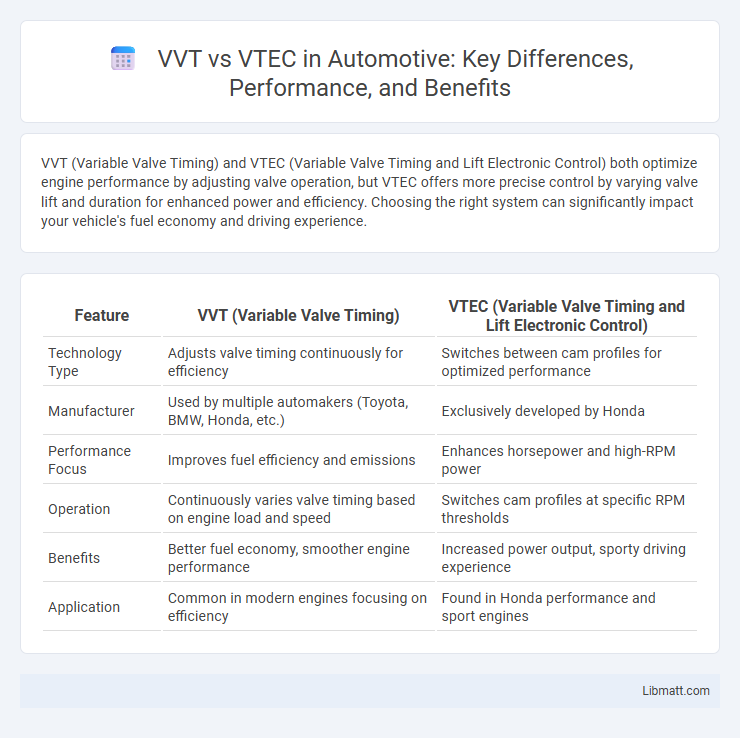VVT (Variable Valve Timing) and VTEC (Variable Valve Timing and Lift Electronic Control) both optimize engine performance by adjusting valve operation, but VTEC offers more precise control by varying valve lift and duration for enhanced power and efficiency. Choosing the right system can significantly impact your vehicle's fuel economy and driving experience.
Table of Comparison
| Feature | VVT (Variable Valve Timing) | VTEC (Variable Valve Timing and Lift Electronic Control) |
|---|---|---|
| Technology Type | Adjusts valve timing continuously for efficiency | Switches between cam profiles for optimized performance |
| Manufacturer | Used by multiple automakers (Toyota, BMW, Honda, etc.) | Exclusively developed by Honda |
| Performance Focus | Improves fuel efficiency and emissions | Enhances horsepower and high-RPM power |
| Operation | Continuously varies valve timing based on engine load and speed | Switches cam profiles at specific RPM thresholds |
| Benefits | Better fuel economy, smoother engine performance | Increased power output, sporty driving experience |
| Application | Common in modern engines focusing on efficiency | Found in Honda performance and sport engines |
Introduction to VVT and VTEC Technologies
Variable Valve Timing (VVT) is an engine technology that adjusts the timing of valve operation to improve performance, fuel efficiency, and emissions. VTEC (Variable Valve Timing and Lift Electronic Control) is Honda's specific implementation of VVT, combining variable timing with variable valve lift for enhanced power delivery and efficiency. Both technologies optimize engine breathing by altering valve events based on RPM and load conditions.
Core Differences Between VVT and VTEC
VVT (Variable Valve Timing) continuously adjusts the timing of valve opening and closing to optimize engine performance and fuel efficiency across varying RPM ranges. VTEC (Variable Valve Timing and Lift Electronic Control) not only changes timing but also switches between different camshaft profiles to provide both low-end torque and high-end power. These core differences highlight VVT's emphasis on seamless timing variation, while VTEC focuses on dual cam profiles for performance versatility.
How VVT Works: Mechanism and Benefits
Variable Valve Timing (VVT) adjusts the timing of the intake and exhaust valves by altering the camshaft position using a hydraulic or electronic actuator, optimizing engine performance across various speeds. This precise control improves fuel efficiency, reduces emissions, and enhances torque by ensuring optimal valve overlap and timing. VVT's mechanism allows engines to seamlessly switch between power and economy modes without sacrificing drivability.
How VTEC Works: Mechanism and Benefits
VTEC (Variable Valve Timing and Lift Electronic Control) operates by switching between different camshaft profiles to optimize valve timing, lift, and duration based on engine speed and load, enhancing both power output and fuel efficiency. The mechanism involves a hydraulic system that engages a rocker arm linked to a high-lift cam lobe at higher RPMs, enabling increased airflow and combustion efficiency. This results in improved performance at high engine speeds while maintaining smooth idling and fuel economy during low-speed operation.
Performance Comparison: VVT vs VTEC
VTEC (Variable Valve Timing and Lift Electronic Control) enhances engine performance by optimizing valve lift and duration for high RPM power, delivering a sportier and more aggressive driving experience. VVT (Variable Valve Timing) improves fuel efficiency and torque across a broader RPM range by continuously adjusting valve timing, providing smoother and more versatile engine response. Your choice between VVT and VTEC depends on whether you prioritize peak performance or balanced daily driving efficiency.
Fuel Efficiency: VVT vs VTEC
Variable Valve Timing (VVT) enhances fuel efficiency by continuously adjusting valve timing for optimal engine performance across various speeds and loads, reducing emissions and improving fuel economy. Honda's Variable Valve Timing and Lift Electronic Control (VTEC) system optimizes fuel efficiency by switching between different camshaft profiles, enabling a balance between power and fuel savings under different driving conditions. While both systems improve fuel efficiency, VVT generally offers smoother, incremental adjustments for everyday driving economy, whereas VTEC delivers more distinct shifts that provide sportier performance alongside efficient fuel use.
Reliability and Maintenance Considerations
VVT (Variable Valve Timing) systems are generally known for their simplicity and fewer moving parts, resulting in lower maintenance costs and higher long-term reliability. VTEC (Variable Valve Timing and Lift Electronic Control) incorporates more complex mechanical components and hydraulic systems, which may increase maintenance requirements and potential for wear over time. Both technologies benefit from regular oil changes and proper engine care, but VVT engines often have a slight advantage in durability under high-mileage conditions.
Cost Implications: VVT vs VTEC
Variable Valve Timing (VVT) systems generally incur lower manufacturing and maintenance costs compared to Honda's Variable Valve Timing and Lift Electronic Control (VTEC) technology, due to simpler mechanical complexity and fewer specialized components. VTEC's advanced cam profile switching mechanism often results in higher production expenses and potentially increased repair costs over time. Businesses and consumers must weigh VVT's cost-efficiency against VTEC's superior performance benefits when considering engine technologies.
Popular Cars Featuring VVT and VTEC
Popular cars featuring VVT (Variable Valve Timing) include the Toyota Camry, Honda Accord, and BMW 3 Series, where VVT improves fuel efficiency and engine performance by adjusting valve timing. VTEC (Variable Valve Timing and Lift Electronic Control) is prominently found in performance-oriented Honda models like the Civic Type R, Integra, and S2000, enhancing power output by optimizing valve lift and timing at higher RPMs. Your choice between VVT and VTEC vehicles will depend on whether you prioritize fuel economy or sporty driving dynamics.
Which Is Better: VVT or VTEC?
VVT (Variable Valve Timing) and VTEC (Variable Valve Timing and Lift Electronic Control) both enhance engine performance by optimizing valve timing but differ in complexity and application. VVT adjusts valve timing continuously for improved fuel efficiency and emissions, while VTEC offers variable valve lift for enhanced power at higher RPMs, making it ideal for sporty driving. Choosing between VVT and VTEC depends on whether the priority is fuel economy and smooth performance (VVT) or high-performance power output (VTEC).
VVT vs VTEC Infographic

 libmatt.com
libmatt.com